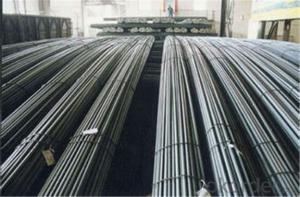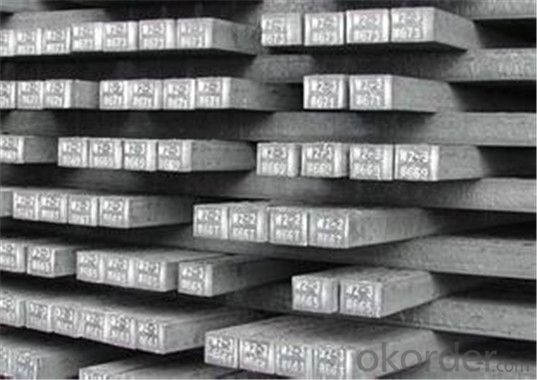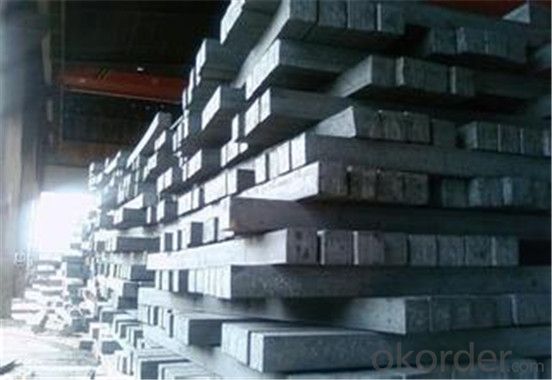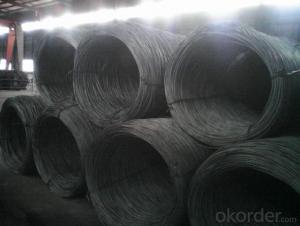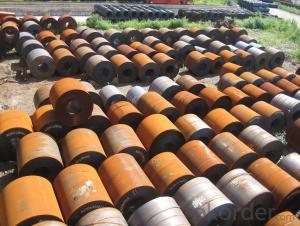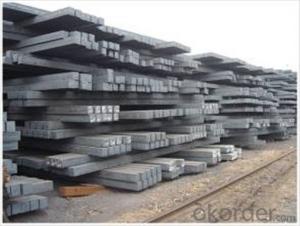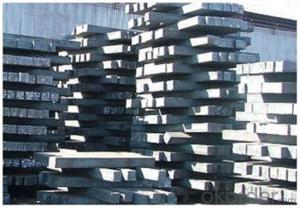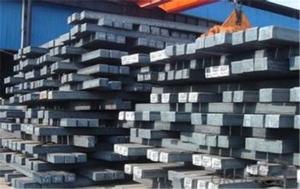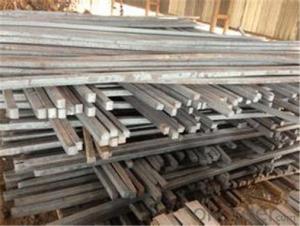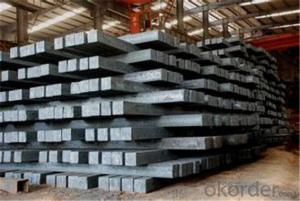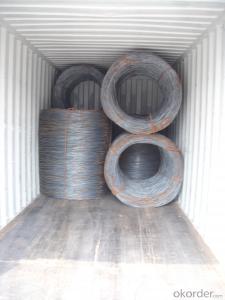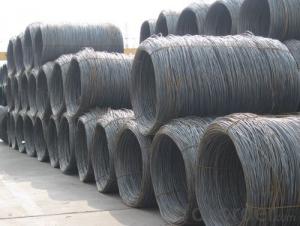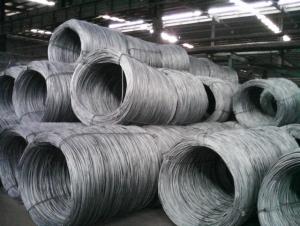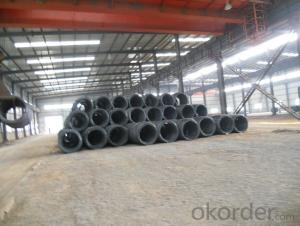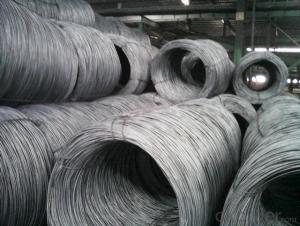Square Steel Billet Hot Sale Q275B/5SP in China
- Loading Port:
- Tianjin
- Payment Terms:
- TT OR LC
- Min Order Qty:
- 600 m.t.
- Supply Capability:
- 45555555 m.t./month
OKorder Service Pledge
OKorder Financial Service
You Might Also Like
Specification
Description of steel billet:
Our company is recognized by ISO9001:2008
1. hot rolled wire rod
2. material: Q195-235
Festures of steel billet:
1. Drawn wire specialist, your wire rod solution
2. ISO9001 Certified Mill &SGS
3. Feature: machinability, high hardness, toughness, corrosion resistant
Specifications of steel billet:
Name: | steel billets |
LENGTH: | 6 meter to 12 meter (+ 50mm) |
Size: | 100*100, 120*120, 150*150, 200*200 |
Grade: | 3SP,5SP,Q235,20MnSi. |
Shape: | Square, Round |
Technique: | Hot-Rolled |
Standard: | ASTM/GB |
BENDING | No more than 5mm in 1 meter |
ANGULAR TWIST | No more than 1 degree per meter and not more than 6 degree over 12 meter length. |
Images of steel billet:
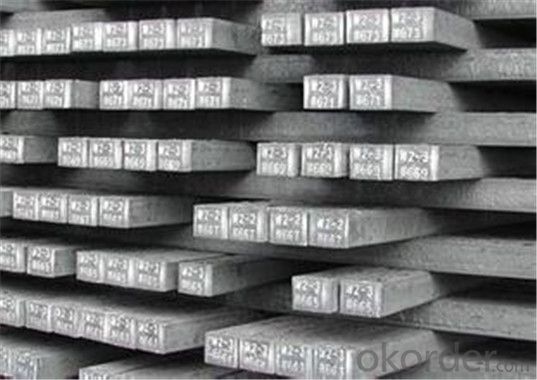
FAQ:
1. What is your package?
Packing situation: standard seaworthy packing or as customer required.
2. How long is the lead time?
Delivery time: 45 days after order confirmed.
3. What payment term do you accept?
Payment: T/T or L/C at sight.
- Q: How is the surface finish of steel wire rod determined?
- The surface finish of steel wire rod is determined through a combination of manufacturing processes and quality control measures. First, the steel wire rod is produced through a hot rolling process, where the steel is heated and passed through a series of rollers to achieve the desired shape and thickness. During this rolling process, the surface of the steel wire rod can develop imperfections such as scale, which is a layer of oxide that forms on the surface due to the high temperatures involved. To remove this scale and improve the surface finish, the steel wire rod may undergo a descaling process, which involves methods like acid pickling or mechanical descaling. After descaling, the steel wire rod may undergo further processes like cold drawing or heat treatment to achieve the desired mechanical properties. These additional processes can also contribute to improving the surface finish of the steel wire rod. To ensure the desired surface finish is achieved, quality control measures are implemented throughout the manufacturing process. This includes regular inspections and testing of the steel wire rod to detect any surface defects or imperfections. Various techniques such as visual inspection, ultrasonic testing, and surface profilometry can be used to evaluate the surface finish and ensure it meets the required standards. In conclusion, the surface finish of steel wire rod is determined through a combination of manufacturing processes such as rolling, descaling, cold drawing, and heat treatment. Quality control measures are also implemented to inspect and test the surface finish, ensuring it meets the desired standards.
- Q: What are the standard dimensional accuracy requirements for steel wire rod?
- The dimensional accuracy requirements for steel wire rod vary depending on its specific application and industry standards. However, there are generally accepted tolerances that are adhered to during the manufacturing and production process. In terms of diameter, the dimensional accuracy requirement typically falls within a certain tolerance limit. For instance, a particular grade of steel wire rod may require the diameter to be within +/- 0.10 mm, allowing for a deviation of up to 0.10 mm from the specified value. This tolerance ensures consistency in size and enables proper fit and function in different applications. Likewise, for the length of the steel wire rod, a dimensional accuracy requirement is set to ensure uniformity and compatibility. The length tolerance may be specified as +/- a certain value, such as +/- 0.5% of the specified length. This tolerance ensures that the wire rod meets the desired length requirements and can be easily incorporated into various manufacturing processes. Furthermore, other dimensional parameters like straightness, surface finish, and ovality may also have specific requirements depending on the intended use of the steel wire rod. These requirements ensure efficient processing, forming, and utilization of the wire rod in different applications, while maintaining the desired quality and performance. It is important to highlight that the precise dimensional accuracy requirements for steel wire rod may vary depending on industry standards, customer specifications, and the intended application. Therefore, it is crucial to consult the relevant standards or communicate with the appropriate stakeholders to determine the exact dimensional accuracy requirements for a specific steel wire rod.
- Q: How is steel wire rod used in the production of wire for wire rope slings?
- Steel wire rod is used in the production of wire for wire rope slings by being first drawn through a series of dies to reduce its diameter and increase its length. This process, known as wire drawing, helps to enhance the tensile strength and flexibility of the wire. The resulting wire is then twisted and braided together to form the strands of the wire rope sling, providing it with the necessary strength and durability for lifting heavy loads safely and reliably.
- Q: How is steel wire rod used in the manufacturing of wire forms for medical devices?
- Steel wire rod is an indispensable element in the production of wire forms for medical devices. It acts as the raw material that is processed and converted into different wire forms used for medical purposes. To begin with, the steel wire rod undergoes a series of procedures such as drawing, annealing, and coating to enhance its properties and make it suitable for medical device applications. Drawing entails reducing the diameter of the wire rod through a sequence of dies, resulting in a thinner and more flexible wire. Annealing is a heat treatment process that improves the wire's ductility and eliminates any residual stresses. Coating, such as electroplating or passivation, is applied to the wire to provide corrosion resistance and enhance biocompatibility. Once the steel wire rod is processed, it can be utilized in the manufacturing of a wide range of wire forms for medical devices. These wire forms include springs, coils, guidewires, catheters, and various surgical instruments. Springs made from steel wire rod are utilized in devices like implantable cardiac pacemakers, where they offer mechanical support and aid in regulating the heart's rhythm. Coils and guidewires made from steel wire rod are used in minimally invasive procedures, such as stenting or catheterization, where they provide flexibility and maneuverability to navigate through blood vessels or other body structures. The high strength and durability of steel wire rod make it suitable for applications where reliability and precision are crucial, such as orthopedic implants or surgical instruments. It can be shaped into intricate forms and sizes, allowing for the production of customized wire forms that meet the specific requirements of different medical devices. Furthermore, steel wire rod's biocompatibility, when appropriately coated or treated, ensures that it does not have any adverse reactions with the human body, making it safe for use in medical applications. In conclusion, steel wire rod plays a vital role in the production of wire forms for medical devices. Through various processing techniques, it is transformed into springs, coils, guidewires, and other wire forms that provide mechanical support, flexibility, and precision in medical applications. The strength, durability, and biocompatibility of steel wire rod make it an excellent choice for the production of wire forms used in medical devices.
- Q: What are the weight and length specifications for steel wire rods?
- The weight and length specifications for steel wire rods vary depending on the specific requirements and standards set by manufacturers and industries. However, typical weight ranges for steel wire rods can be anywhere from a few kilograms to several metric tons. Similarly, the length of steel wire rods can vary, but they are commonly available in lengths ranging from a few meters to several kilometers.
- Q: How is steel wire rod used in the manufacturing of screws and bolts?
- Steel wire rod is used in the manufacturing of screws and bolts as it serves as the primary raw material. The wire rod is first drawn into the desired diameter and then cut into specific lengths to create the base material for screws and bolts. This wire is then further processed through various manufacturing processes, including heading, threading, and heat treatment, to shape and strengthen it into the final product. So, steel wire rod is an essential component that provides the necessary strength and durability to screws and bolts.
- Q: What are the different surface finishes available for steel wire rods?
- There are several surface finishes available for steel wire rods, including hot-dip galvanized, electro-galvanized, phosphatized, and uncoated. Each finish offers unique properties and benefits depending on the intended application and environmental conditions.
- Q: What are the different heat treatment processes applied to steel wire rod?
- Some of the different heat treatment processes applied to steel wire rod include annealing, quenching and tempering, normalizing, and case hardening. Annealing involves heating the wire rod to a specific temperature and then slowly cooling it to improve its ductility and remove internal stresses. Quenching and tempering involves rapidly cooling the wire rod to increase its hardness and strength, followed by tempering to reduce brittleness. Normalizing is a similar process to annealing, but with a slightly different cooling rate to achieve desired mechanical properties. Case hardening involves adding a thin layer of a harder material to the surface of the wire rod to improve wear resistance.
- Q: What are the different straightening methods for steel wire rod?
- There are several different straightening methods for steel wire rods, each designed to achieve specific results based on the desired level of straightness and the type of wire being processed. Some of the most common straightening methods used in the industry include: 1. Mechanical straightening: This method involves passing the wire rod through a series of straightening rolls or dies that are positioned at various angles. The rolls or dies apply pressure to the wire, gradually bending it back into a straight shape. Mechanical straightening is commonly used for low carbon steel wire rods. 2. Thermal straightening: In this method, the wire rod is heated to a specific temperature and then cooled rapidly, causing the metal to contract and straighten. The wire is usually passed through a series of water or air cooling chambers to achieve the desired straightness. Thermal straightening is typically used for medium to high carbon steel wire rods. 3. Hydraulic straightening: This method utilizes hydraulic cylinders to apply pressure to the wire, straightening it by bending it in the opposite direction of its natural curve. Hydraulic straightening can be used for various types of steel wire rods, but it is especially effective for high-strength wires. 4. Rotary straightening: Also known as rotary swaging, this method involves placing the wire rod in a rotating drum or cage that contains a series of tapered rolls. As the wire passes through the rolls, it is gradually straightened due to the forces exerted by the rotating rolls. Rotary straightening is commonly used for stainless steel wire rods and other high-alloy materials. 5. Combination methods: Some manufacturers use a combination of different straightening methods to achieve the desired results. For example, a wire rod may undergo initial mechanical straightening followed by thermal straightening to further improve its straightness. It is important to note that the choice of straightening method depends on various factors such as the type of steel wire rod, its diameter and tensile strength, and the desired level of straightness. Additionally, each method has its own advantages and limitations, so it is crucial to select the most suitable method based on the specific requirements of the wire rod application.
- Q: What are the common defects in steel wire rod?
- Common defects in steel wire rod can include surface cracks, internal voids or inclusions, improper shape or diameter, lack of uniformity in chemical composition or mechanical properties, and poor surface finish.
Send your message to us
Square Steel Billet Hot Sale Q275B/5SP in China
- Loading Port:
- Tianjin
- Payment Terms:
- TT OR LC
- Min Order Qty:
- 600 m.t.
- Supply Capability:
- 45555555 m.t./month
OKorder Service Pledge
OKorder Financial Service
Similar products
Hot products
Hot Searches
Related keywords
